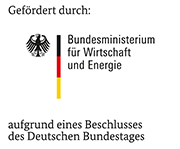15507N

| Period: | 01.02.2008 - 31.07.2010 |
|---|---|
| Partner: | - |
| Funder: | Arbeitsgemeinschaft industrieller Forschungsvereinigungen e.V. |
| Project Manager: | Dr. Ulrich Harm |
| Research Group: | Electrochemistry |
Aims
In this project an new primer for the corrosion protection of galvanised steel, being composed of phosphonic acids or phosphonates should be developed. This type of primer is environmentally friendly because of the very low need of chemicals and the possibility to use only water based solutions for the whole process.
Working steps
1. First of all some special phosphonic acids were synthesised.
2. Layer formation (e.g. SAM formation in the case of monophosphonic acids) on electro-galvanized and hot dip galvanized steel surfaces were examined by contact angle measurements.
3. Different corrosion tests showed, which kind of phosphonic acid (or phosphonate) layers could increase the corrosion resistance with and without additional top covers.
To optimize the performance of these layers, also trials with combinations of phosphonic acids and special thio-compounds or the usage of monomer SAM head groups were conducted.
Results
After synthesis of some suitable phosphonic acids, important steps in the development of the intended coatings were first of all attempts to achieve a successful layer formation on pretreated galvanised steel surfaces with diluted aqueous solutions of phosphonic acids or phosphonates. Contact angle measurements of the pretreated galvanised steel surfaces before and after dipping in the phosphonic acid solutions indicated a succussful layer formation (e.g. SAM formation with mono- or diphosphonic acids) on electrogalvanised steel as well as on hot dip galvanised steel.
Examinations of the coated galvanised steel sheets showed, that visible acid etching of the zinc surface during the dipping process can be avoided by using adequate conditions (dipping time, temperature, pH - values, additional salts and solvents.
Different pretreatment methods of the zinc surfaces (before SAM- or multilayer formation) were investigated including methods for etching / activation in alkaline and acid aqueous solutions and also the usage of conversion layers like the technical important zinc phosphate layers or some nanoceramic coatings.
Corrosion tests like salt spray tests or the immersion of galvanised steel sheets with different mono- or multilayers in aerated 1 % NaCl (with or without an organic sealant) indicated, that some of this phosphonic acid layers are able to inhibit the corrosion process significantly,
especially the white rust formation. In particular, some multilayers, which are formed with multiphosphonic acids like Phytic acid or DETPMPA (Dequest 2060) in the presence of small amouts of spezial salts [MnSO4 or Cr(NO3)3 ] induced strong corrosion inhibition effects (reduced white rust formation). In some cases, this could be further optimised by an additional treatment with spezial thio-compounds.
Different corrosion tests (e.g. salt spray tests and alternating climate tests) with technical lacquerings showed, that also the corrosion creep at defects of the top coat (edge of the sheets, scratches) can be inhibited with some phosphonic acid layers, if the zinc surface had been carefully degreased and adequately pretreated before (alkaline treatment and subsequent acid activation of the surface).

Das IGF-Vorhaben Nr. 15507N der Forschungsvereinigung DECHEMA e.V., Theodor-Heuss-Allee 25, 60486 Frankfurt am Main wurde über die AiF im Rahmen des Programms zur Förderung der industriellen Gemeinschaftsforschung (IGF) vom Bundesministerium für Wirtschaft und Energie aufgrund eines Beschlusses des Deutschen Bundestages gefördert.
Dr. Klaus-Michael Mangold
Telefon: +49-(0)69 / 75 64-327
E-Mail: mangold